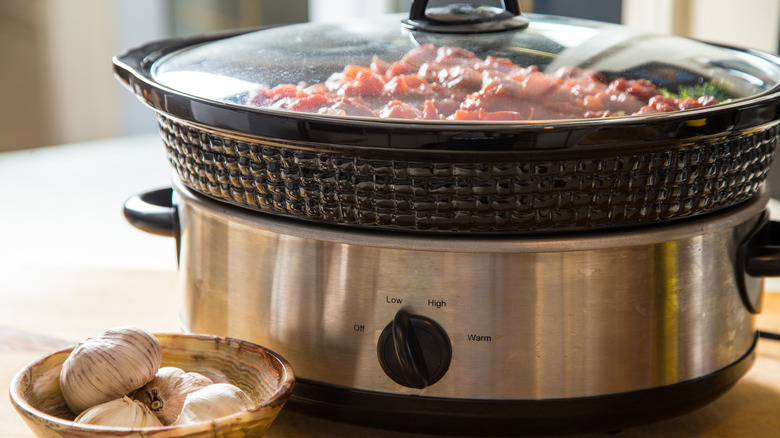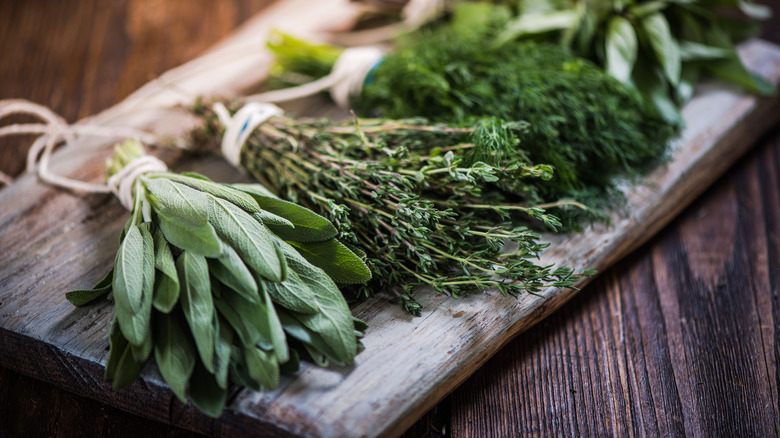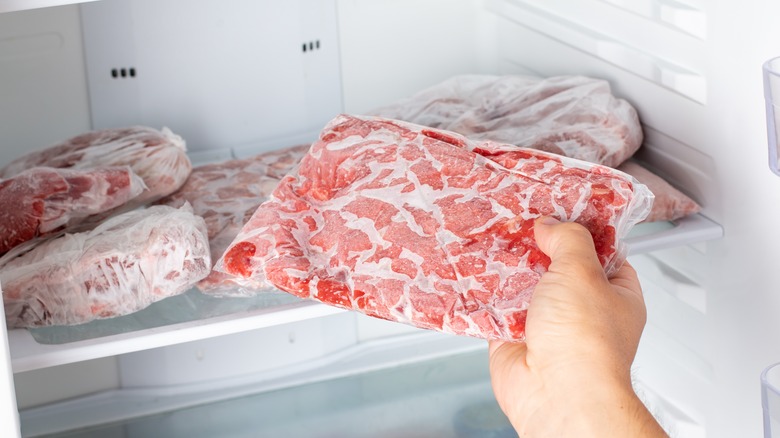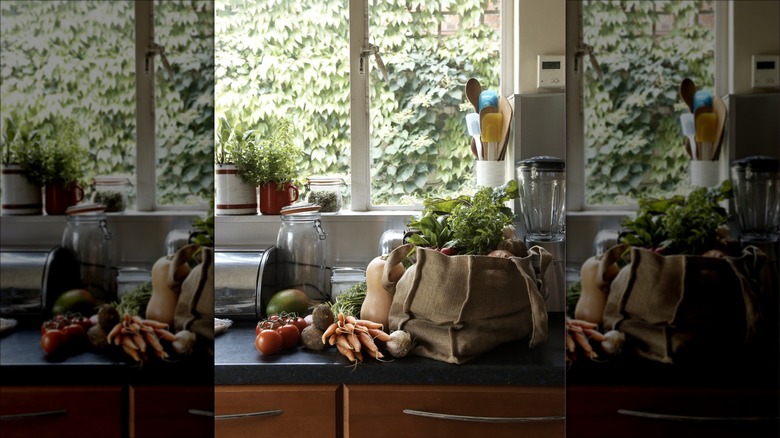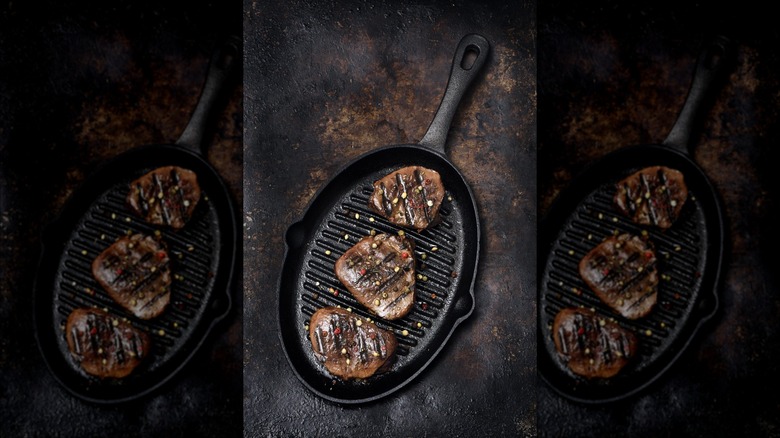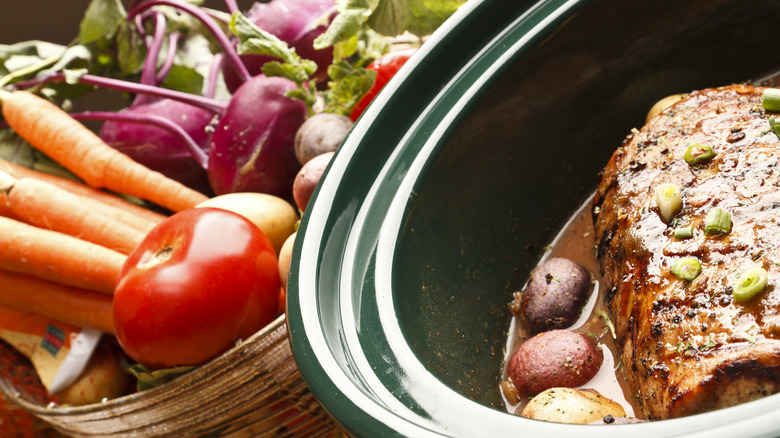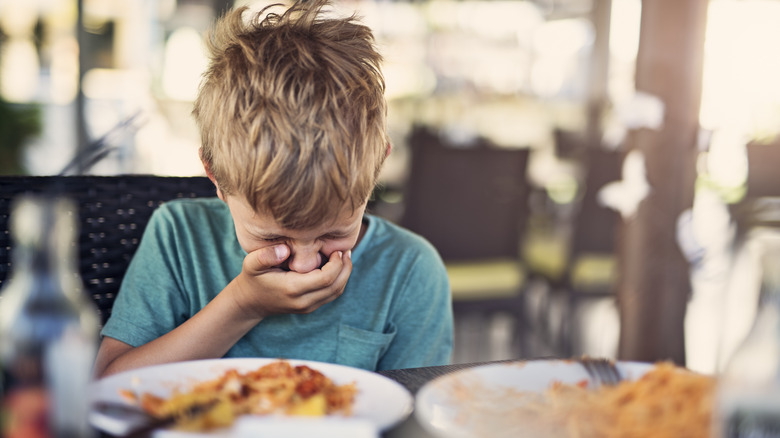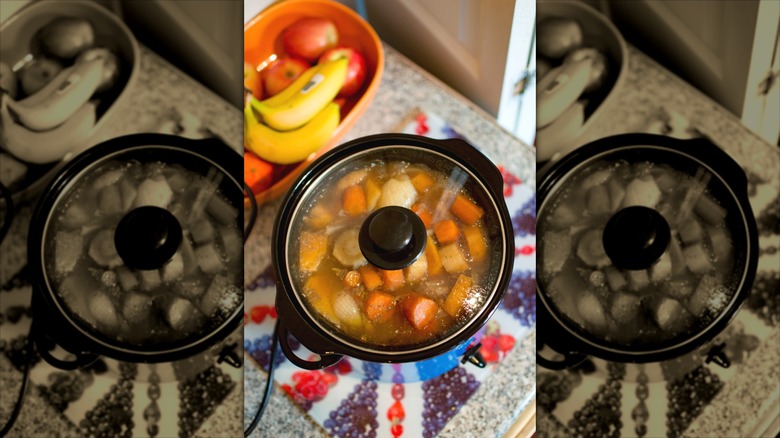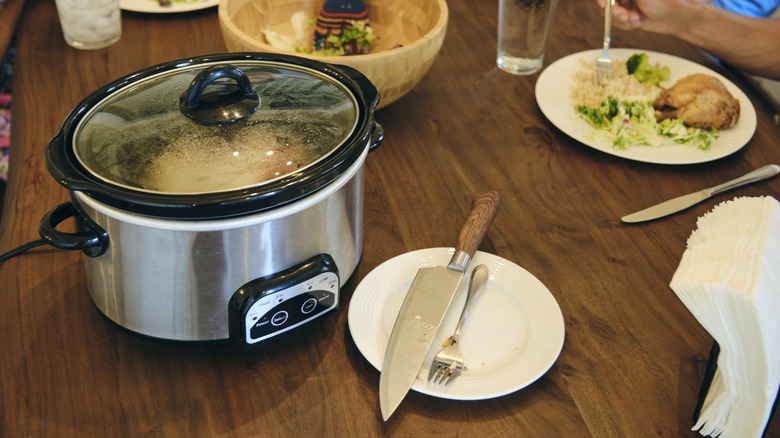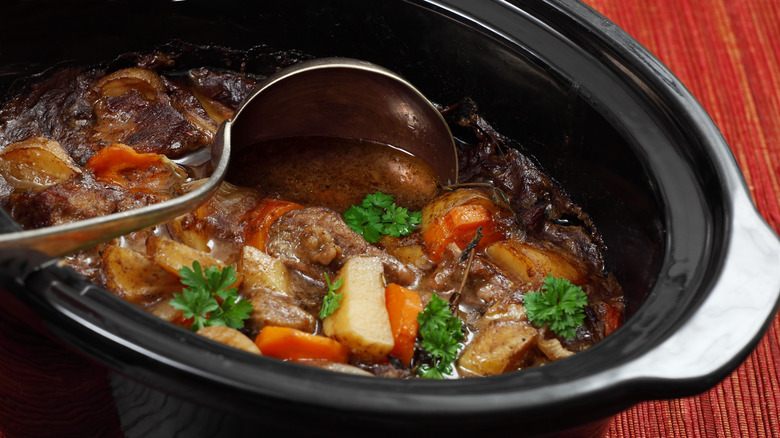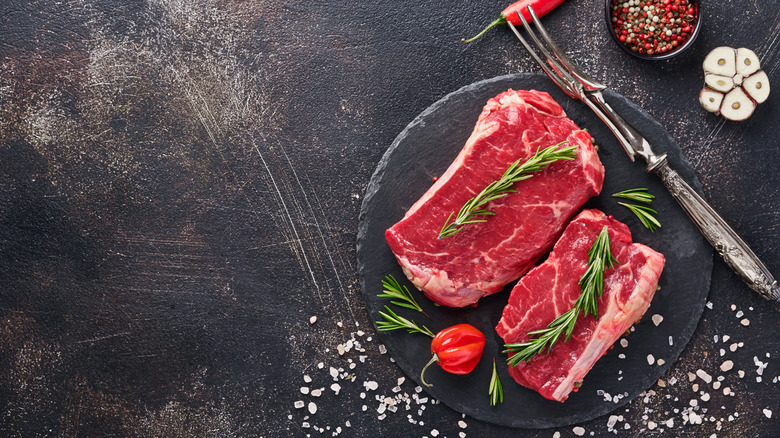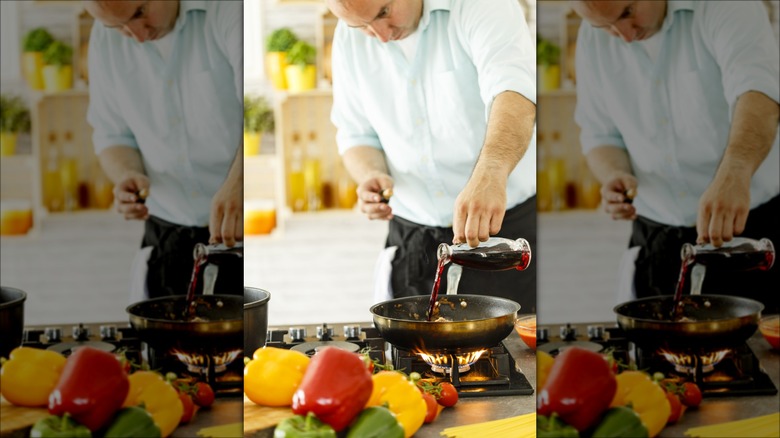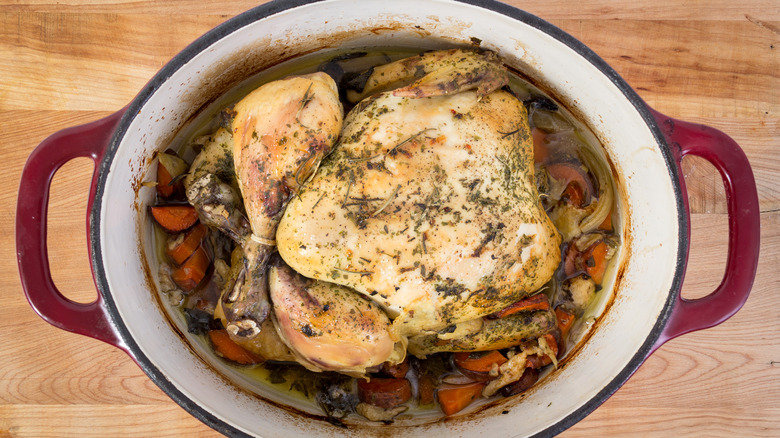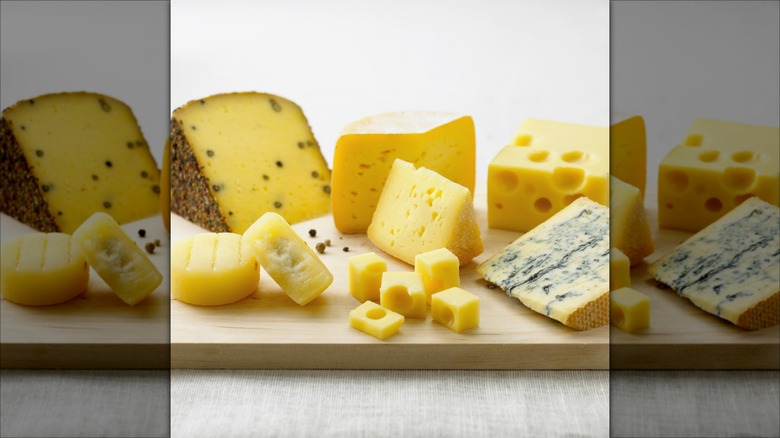Stop Making These Mistakes With Your Slow Cooker
Asked any person who's used one — slow cookers count among the most forgiving methods of cooking around. That makes it easy to forget that it's still possible to make all sorts of missteps with your slow cooker, from meats that are way undercooked to cheese curds bigger than anything Miss Muffet ever thought of putting in a bowl. But the difference between being able to salvage a ruined dinner or not comes down to knowing what kinds of common mistakes people make with the slow cooker and knowing what to do to avoid making those mistakes.
But there's more to slow cooker mistakes than subpar meals. The other types of errors people run into with this handy cooking tool come down to logistics, from not knowing how to make the most of using a slow cooker to cooking the wrong types of food in it. While it's true that the average slow cooker is the kitchen equivalent of a superhero, some foods are kryptonite in the Crock. In other words, they're best left to other cooking methods. We've highlighted some of the most common slow cooker mistakes so that you can learn what they are and more importantly, how to avoid them altogether.
1. Tossing fresh herbs in too early
Fresh herbs, dropped into the slow cooker at the right time, add hints of flavor. They're the slow cooker equivalent of a butterfly kiss on the cheek — subtle, but oh-so sublime when done right. Due to their delicate makeup, your fresh herbs will be most flavorful if you wait to add them until the last 30 to 60 minutes of cooking. If they're allowed to cook for too long, they'll likely lose their flavor.
This is essentially the opposite of how to use dried or woody herbs in the slow cooker, which should go in at the beginning of the cooking process. These must cook longer to coax the flavorful oils from within them and also to soften them up. You may also find that your recipes cooked in the slow cooker require more dried herbs than those recipes cooked by other means.
Consider this an order of operations, then, for cooking with herbs — that is, toss in dried herbs, then fresh herbs — and your slow cooker recipes will have the best flavor. If the dish still needs a bit of a kick, add a few more dried herbs at the end.
2. Adding frozen food to the slow cooker
Instant Pots have made home cooks forget that slow cookers don't have the same kind of cooking power when it comes to cooking frozen meat (or frozen anything, really, but meat in particular). That's because it'll take too long for the meat to reach 165 F, allowing harmful bacteria like salmonella to grow.
While it's true that your average slow cooker reaches temps as high as 280 F, which is high enough to kill off bacteria under normal circumstances, the cooker remains in what's called the danger zone — 40 to 140 F — for too long to kill off the bugs in the way that the Instant Pot can. What may throw inexperienced home cooks off is the parameters at which pressure cookers like Instant Pot function. They work like slow cookers at some settings, but their pressure cooker feature — something that your slow cooker lacks — means that starting with frozen meat isn't an issue. The pressure cooker heats up rapidly, heating your meat to safe temps along with it. In light of that, if you have frozen meat, thaw it before putting it in the slow cooker.
3. Not timing your veggies
Cooking veggies in the slow cooker requires you to follow an order of operations — otherwise, you'll end up with crunch potatoes and soggy asparagus. Dried plant foods like beans take the longest to cook, sometimes up to six or eight hours. They also need to soak for around six hours before cooking. If you're cooking your recipe overnight, these foods need to go into the slow cooker first. On high, they'll cook in six hours; on low, it'll take eight hours.
Veggies in the middle range like cabbage, green peppers, and eggplant require two or three hours of cooking. Most other veggies will require 30 minutes or less to cook in the slow cooker, with mushrooms, tomatoes, and greens taking a fraction of the time. Going back to the beans, if they cook for eight hours before they're done, then you'll want to toss the root veggies in about three hours before the stew is done.
4. Putting un-seared meat in the cooker
Searing meat before putting it into the slow cooker seems a bit like cooking your meat before you cook your meat. However, from a taste perspective, you miss out on a lot of flavorful complexity if you don't sear it first. Called the Maillard reaction, this step caramelizes the meat's exterior and enhances its umami vibe, giving it a savory punch. It makes meat look, feel, and taste like meat, brown, with a crisped surface covering tender insides. Coating the meat in seasoned flour takes this process one step further. The flour creates the thick, saucy goodness that people often associate with stews cooked in the slow cooker.
Will it harm your meat if you don't sear it? Technically, there is no requirement that you brown any meat before you put it into a slow cooker (just don't make this mistake with ground beef). However, it's likely to taste drab at best if you skip this step in the cooking process.
5. Not allocating the maximum time to cook meat
Here's a hypothetical for you. If you were to make a surf-n-turf recipe, would it be okay just to toss the beef and the fish into the slow cooker at the same time? You won't get a demerit for saying yes, but really, the answer is no. Different meats have different cooking times in the slow cooker just as they do on the stove. Granted, those cooking times run longer in the slow cooker, but the principle is the same. You'll get the best results if you cook each type of meat in the right way and for the right length of time.
For example, meat cuts like pork roasts take the longest, with the slow-burn cooking method requiring almost 10 hours of cooking time. If the same roast is cooked on high, you'll need about seven hours. Beef roast comes in somewhere in the middle at eight hours for a slow cooking time and about six hours for a fast cooking time. Fish takes about one to three hours. Now, going back to the hypothetical surf-n-turf example, the beef should go into the pot first. The fish goes in last. Everything might come out of the pot at the same time at the end of the cooking process, but that's not the case for how the ingredients go in — especially when it comes to meat.
6. Leaving food on warm in the cooker
If anything is set-it-and-forget-it, it's the slow cooker, but this cooker advantage is also one of its dangers. When you've cooked something in a Crockpot, you face the temptation to leave the food in the cooker on warm until you're ready to eat it. However, the slow cooker isn't just a place that warms up your food. It also makes a comfy nest for less desirable inhabitants, like botulism and other harmful bacteria, under certain conditions.
This concerns what food scientists call the "sweet spot" — 40 to 140 F — though don't be fooled. The results are anything but sweet should you be on the receiving end of food left at the sweet spot for too long. At those temperatures, the microscopic creepy crawlies that have settled on your food become active. It's these conditions that are responsible for making rice and other foods no-nos on leftovers night.
This isn't to say that you can't leave your food warming in your slow cooker at all. You can, but you do have to limit the amount of time. Leaving your slow cooker on the "warm mode," for up to two hours is okay. Four hours is pushing it. Once your food has been on warm for an hour or two, put it into the fridge for safekeeping.
7. Overfilling your slow cooker
Bargain shopping aficionados know that you shouldn't shop when you're hungry because you'll put too much food in your cart. Maybe a similar rule should exist for slow cooker cooking because the tendency to load it to the brim is also there (though this may happen even if you're not hungry while you're cooking). This practice will cost you, just as putting too much food in your cart costs you. In this case, an overfull slow cooker means that your food may cook unevenly, leaving you with raw, crunchy carrots and mushy noodles in the same dish, hypothetically speaking. This is unappetizing at best.
An additional challenge comes with the practice of filling your slow cooker too full. As the liquids get to bubbling, water condenses on the lid. This creates a seal that acts as a suction, pulling the liquid out of the cooker, and depositing it on the counter in small puddles. If you always have a liquid mess around the bottom of your slow cooker, this is why.
The solution in both cases is to fill the cooker only about two-thirds of the way full. The contents cook more evenly, allowing the flavors to steep into the food and cooking the food all the way through in the process. The bubbling-over action is mitigated because the top of the food is nowhere near the top of the slow cooker. Food simmers as it should, instead of siphoning out the sides.
8. Opening the lid too much
The old adage about a watched pot never boiling gets an update here. A slow cooker whose lid is removed too many times never boils. Blame this phenomenon on the heat loss that happens when you remove the lid. The impetus to do so is innocent enough — after all, the food needs a good stir, or maybe you feel as if it could use a bit more seasoning.
Toward the end of your cooking and brewing session, removing the lid to stir or add seasonings is okay. However, this is the only time you should remove the lid from the slow cooker. Midway through the cooking process, removing the lid also removes between 10 and 20 degrees from the food's temperature. Everything about the slow cooker pretty much comes down to the slow burn. If cooking on the stove qualifies as a foodie sprint, cooking in the slow cooker definitely runs into marathon territory. True enough, temperatures can eventually get very hot in your slow cooker — up to 280 F — but not for hours and hours and hours.
Each peek under the lid adds up to five minutes or more to your food's cooking time. So, for example, if you've checked the food 12 times during an eight-hour cooking period, you've lengthened dinnertime by an hour. That's a lot of time to lose when you're hungry.
9. Adding too much liquid
Slow cookers are the cooking equivalent of a tropical rainforest, constantly soggy and getting soggier with each hour of cooking. Worst of all, if you didn't know better, you'd swear that the cooker manufactures its own rain, just like the trees in the rainforest do. This analogy isn't far from the truth. The construction of the cooker keeps liquids inside it and discourages evaporation. This explains why there is so much steam clinging to the lid of the cooker once cooking ends. Additionally, the steam on the lid eventually drips back down into the food, causing it to get soggy as the steam from the lid rains down into the food.
Some experienced foodies make it a practice to put less liquid into their recipes if they're cooking them in the slow cooker instead of on the stove for this very reason. They'll cut the liquid by as much as half of what the recipe calls for. If the thought of reducing the liquid in your slow cooker by that much makes you nervous, you might try reducing the amount of liquid you put into your favorite recipes but do so in increments until you find just the right amount of liquid for cooking that particular recipe in your slow cooker.
10. Cooking expensive cuts of meat in the cooker
Your investment in a slow cooker represents one of the best money-saving moves you could have made, and not because it allows you to batch cook (though that certainly helps your bottom line when you can do it). Instead, it's important to look at one of the other benefits of having a slow cooker — what it does for your cheap cuts of meat is nothing short of amazing. It takes them from chewy and tough to tender and delicious, all in the space of about six or eight hours or so. Chuck steak roasts, pork shoulders, and beef short ribs all go from GADS! to gourmet in the tender care of your cooker.
That's why it's a big mistake to throw your better cuts of meat, like ribeyes or filet mignon, into the slow cooker. By their makeup, they're more tender and require less cooking time because they aren't challenged with the abundant connective tissues that are found in cheaper cuts of meat. So, if you're going to splurge on a fancy cut of meat, cook it in a manner befitting it. Save all of your other cuts of meat for the slow cooker. Your wallet and your tummy will thank you.
11. Cooking with alcohol
In the right circumstances, adding wine to dinner creates succulent meat dishes, savory poached veggies and fish, and an overall tenderness that's hard to beat. The operative words here are "the right circumstances," and inside a slow cooker isn't the right circumstance for cooking with wine and other alcohol.
If anything, slow cookers plus boozy recipes equals a drunken dinner. This has to do with the evaporation rate of different types of alcohol. Normally, the stove's rapid heating ability makes the boozy part of the alcohol evaporate, leaving behind the components that are known for making food tender and tasty. Slow cookers got their name for a reason. Eventually, the slow cooker heats up to temps that might give the stove a run for its money, but that process takes hours. In the meantime, the booze in your recipe isn't evaporating, leaving your dinner with all the bitterness of booze gone wrong.
There are some instances where you can add alcohol to a meal you'll cook in the slow cooker, but usually, those involve either pouring the alcohol in at the last minute or cooking some of the recipe on the stove before you transfer it to the slow cooker. If you'd still like to experiment with wine in your recipes, you may find it helpful to cook from recipes that are specifically adapted to such a task until you get a feel for how to do it.
12. Forgetting to layer your foods properly
Food that's improperly layered in the slow cooker opens up the potential for meals that aren't cooked evenly. This has to do with putting quick-to-cook foods at the bottom and slow-to-cook foods at the top of the cooker, though ideally, this order should be the opposite. The bottom layer of your slow cooker should have foods like potatoes, turnips, some cuts of meat, and other foods that require longer cooking times. From a mechanical perspective, the heat at the bottom of the cooker is the greatest at the bottom. Putting denser, heartier foods closer to this heat source ensures that they cook all the way through.
Less dense foods, like green beans and bell peppers, like the middle of the cooker. Foods with a high water content, such as spinach or peas, as well as fresh herbs, cook best at the top of the pot, away from the most intense heat. And some foods, like your meats, will cook by themselves for some time before you add the other less hearty foods because the cooking times for those other foods are less.
Finally, it's also worth noting that the slow cooker usually has just a couple of cooking settings, with low being 160-ish degrees at the lowest temps. Such temperatures still cook the densest foods but it will take longer for food to finish cooking even if you layer it correctly.
13. Curdling the dairy by overcooking
The quality that makes cheese so dang tasty when it's melted is also the thing that will make it and other dairy curdle in the slow cooker. The trick isn't to avoid cooking with dairy in the slow cooker. Rather, it's knowing how to cook with dairy in your recipes to avoid the dreaded curdling syndrome.
First, some types of dairy — fatty cheeses such as cheddar or Parmesan, for example — hold up better in the slow cooker. From a curdling perspective, the more fat a cheese has, the less curdling happens, though this has its limits.
Second, just because a cheese has a lower fat content doesn't mean you can't add it to your slow cooker recipes. It's okay to do this, but you want to wait until the last half hour to hour of cooking before you add in the melty stuff. When it comes to slow cooking, cheese should be one of the final ingredients you drop into the slow cooker. This isn't just for cheese, by the way — the same holds true for all dairy products you intend to cook with. They go in last.
